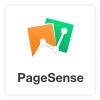20 Top Heatmaps and Session Replay Tools
The market for heatmap and session replay software has heated up in the past couple of years. Heatmap and session replays tools allow marketers to "see" what is happening on their websites. A heatmap displays cold and hot areas of where users interacted. While session replay lets marketers watch individuals sessions. These tools are good compliments to standard website analytics software.

Clarity is a free user behavior analytics tool that helps you understand how users interact with your website. Supported features include: Session Recordings. Heatmaps (or heat maps) ML Insights.
Visit website➔
The global leader in digital experience intelligence and analytics, Contentsquare helps optimize and improve your users digital experience.
Visit website➔
Crazy Egg is an analytics platform that tracks and optimizes website visitor behavior so you can improve the user experience and increase your conversion rates.
Visit website➔
FullStory is a web-based digital intelligence system that helps optimize the client experience. It enables users to track and monitor each customer activity.
Visit website➔
Glassbox provides digital customer experience analytics for web and mobile apps. Drive revenue, profitability & loyalty with optimized digital CX.
Visit website➔
Hotjar is a product experience insights tool that gives you behavior analytics and feedback data to help you empathize with and understand your customers.
Visit website➔
LiveSession helps you analyze users' behavior, improve UX, find bugs, and increase conversion rates using session replays, and event-based product analytics.
Visit website➔
LogRocket combines session replay, error tracking, and product analytics – empowering software teams to create the ideal web and mobile product experience.
Visit website➔
Lucky Orange includes heatmaps, visitor recordings, chat, announcements, surveys, form analytics, conversion funnels and more.
Visit website➔
Medallia's software platform provides keen insights to improve customer experience, contact center experience, employee experience and digital experience.
Visit website➔
Mouseflow is a behavior analytics platform used to optimize website experiences towards improving conversions, perfect for UX professionals.
Visit website➔
Plerdy allows you to track visitors' behavior and find out what they're doing after they arrive on a site.
Visit website➔
Quantum Metric performs a full session replay capture. The event engine can be tailored to capture what you need to understand the user experience and inform product improvement.
Visit website➔
Smartlook is a cloud- and mobile-based quantitative analytics solution that helps businesses of all sizes with user behavior and insights.
Visit website➔
UXCam is the market leader in app experience analytics. We empower mobile teams with fast, contextual and high-fidelity insights.
Visit website➔
VWO is the world's leading web testing and conversion optimization platform that enables growing businesses to optimize their web experience
Visit website➔
Using your target audience, WEVO is the only tool that pinpoints conversion roadblocks and provides recommendations to increase website conversion Pre-Live.
Visit website➔
Yandex.Metrica is a powerful web analytics system combining advanced reporting tools with heat maps and session replay.
Visit website➔
Measure your key website metrics, understand your visitors' online behavior, and give them a personalized website experience to boost conversions.
Visit website➔Good to know...
How do heatmap tools work?
Heatmap tools work by tracking and analyzing user interactions with a website or application. This data is then displayed in a visual representation, typically using colors to indicate the intensity or frequency of user activity.
Heatmap tools typically use JavaScript to track user activity on a website or application. This allows them to record clicks, mouse movements, and scrolling behavior, as well as other actions such as form submissions and page views. The data is then sent to a server where it is processed and analyzed.
Once the data has been analyzed, the heatmap tool generates a visual representation of the user activity. This is typically displayed as a heatmap, with colors used to indicate the intensity or frequency of user interactions in different areas of the page. Areas that are clicked more often or scrolled through more frequently will be represented by warmer colors, while areas with less activity will be represented by cooler colors.
Heatmap tools may also provide additional data such as click-through rates, conversion rates, and bounce rates, allowing website or app owners to identify areas of the site that may need improvement or optimization.
What are some examples of companies that have successfully used heatmap tools to improve their websites or apps?
There are many companies that have successfully used heatmap tools to improve their websites or apps. Here are a few examples:
- Airbnb: Airbnb used a heatmap tool to identify areas of their website where users were dropping off, and then made improvements to those areas to increase conversion rates.
- Spotify: Spotify used heatmap tools to understand how users were interacting with their music player, and used that data to improve the user experience.
- Dropbox: Dropbox used heatmap tools to optimize their pricing page, resulting in a 10% increase in conversion rates.
- HubSpot: HubSpot used heatmap tools to understand how users were interacting with their blog, and used that data to improve the layout and design of their blog pages.
- Expedia: Expedia used heatmap tools to optimize their checkout process, resulting in a 12.5% increase in conversions.
- Booking.com: Booking.com used heatmap tools to optimize their search results pages, resulting in a 10% increase in bookings.
Overall, heatmap tools are a valuable tool for any company looking to improve their website or app, and can provide valuable insights into how users interact with their products. By using heatmap tools to identify areas for improvement, companies can make data-driven decisions to improve user experience and increase conversions.
Why should my company invest in a heatmap tool?
Heatmap software can provide valuable insights into how users interact with your website, which can help you improve the user experience and increase conversions. Here are a few reasons why you might want to consider purchasing a heatmap software:
- Identify areas of high engagement: Heatmaps allow you to see which areas of your website are getting the most clicks or attention from users. This information can help you optimize your website design and content to better engage your audience.
- Understand user behavior: Heatmaps can show you how users are interacting with different elements on your website, such as buttons, links, and forms. This can help you identify potential usability issues or barriers that may be preventing users from completing desired actions on your website.
- Optimize website design: By analyzing heatmap data, you can identify areas of your website that may need design improvements, such as changing the layout, color scheme, or font size. Making these changes can help improve the overall user experience and drive more conversions.
- A/B testing: Heatmaps can be used in conjunction with A/B testing to help you evaluate the effectiveness of different design or content changes. By comparing heatmaps of two different versions of a web page, you can see which version performs better and make data-driven decisions about future design changes.
Heatmap software can provide valuable insights into user behavior on your website, which can help you optimize your website design, improve the user experience, and increase conversions.
What are the different types of heatmap tools available?
There are several different types of heatmap tools available, each with its own strengths and weaknesses. Here are some of the most common types of heatmap tools:
Click Heatmaps: Click heatmaps track user clicks on a website or application, providing a visual representation of the areas that users are clicking on. These heatmaps can help website owners identify which areas of a page are getting the most attention, and can be used to optimize the layout and design of a website or application.
Scroll Heatmaps: Scroll heatmaps track user scrolling behavior, providing a visual representation of how far users are scrolling down a page. These heatmaps can help website owners identify which areas of a page are getting the most attention, and can be used to optimize the placement of important content.
Move Heatmaps: Move heatmaps track user mouse movements on a website or application, providing a visual representation of where users are moving their mouse. These heatmaps can help website owners identify which areas of a page are getting the most attention, and can be used to optimize the placement of important content.
Attention Heatmaps: Attention heatmaps track how long users spend looking at different areas of a page, providing a visual representation of which areas are getting the most attention. These heatmaps can help website owners identify which areas of a page are most engaging, and can be used to optimize the placement of important content.
Conversion Rate Heatmaps: Conversion rate heatmaps track which areas of a website or application are driving the most conversions, providing a visual representation of which elements are most effective at converting visitors into customers. These heatmaps can be used to optimize the design and layout of a website or application to increase conversion rates.
Can heatmap tools be used for A/B testing?
Yes, heatmap tools can be used for A/B testing. A/B testing involves creating two versions of a webpage or application and testing them against each other to determine which version performs better. Heatmap tools can be used to track user behavior on both versions of the webpage or application and provide valuable insights into which version is more engaging and effective.
For example, you could create two versions of a landing page with different designs, layouts, or calls-to-action. By using a heatmap tool to track user behavior on both versions, you can see which version is getting more clicks, engagement, or conversions. This can help you make data-driven decisions about which version of the landing page to use going forward.
Heatmap tools can also be used in conjunction with other A/B testing tools, such as split testing software, to provide a more comprehensive understanding of user behavior. By combining A/B testing with heatmap analysis, website owners can gain valuable insights into which elements of their website or application are most effective at engaging users and driving conversions.